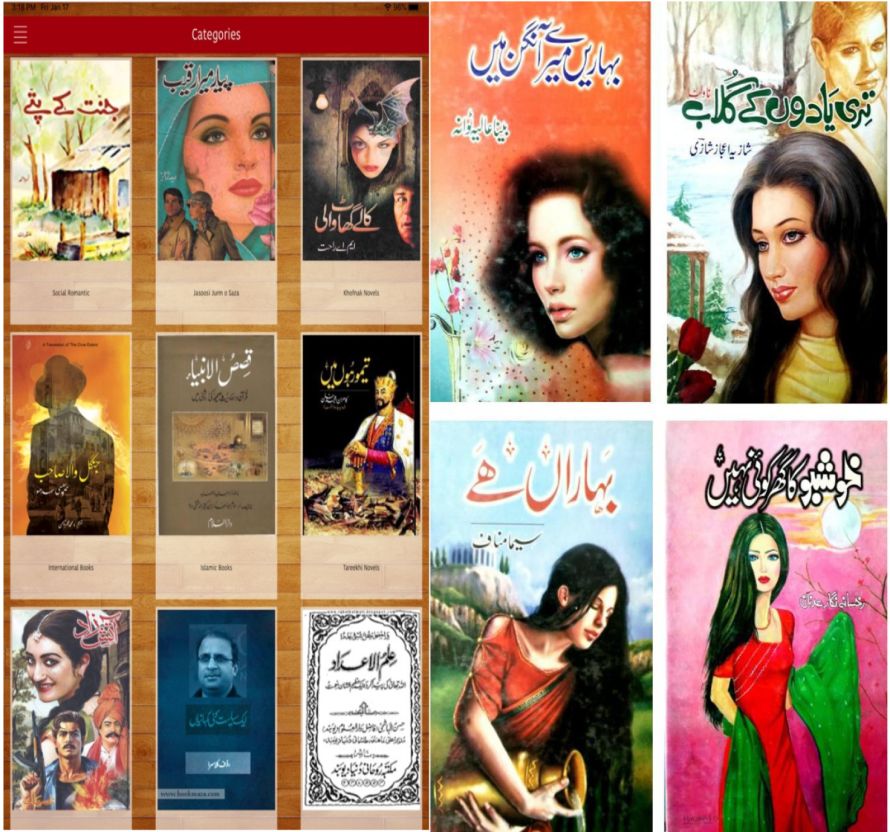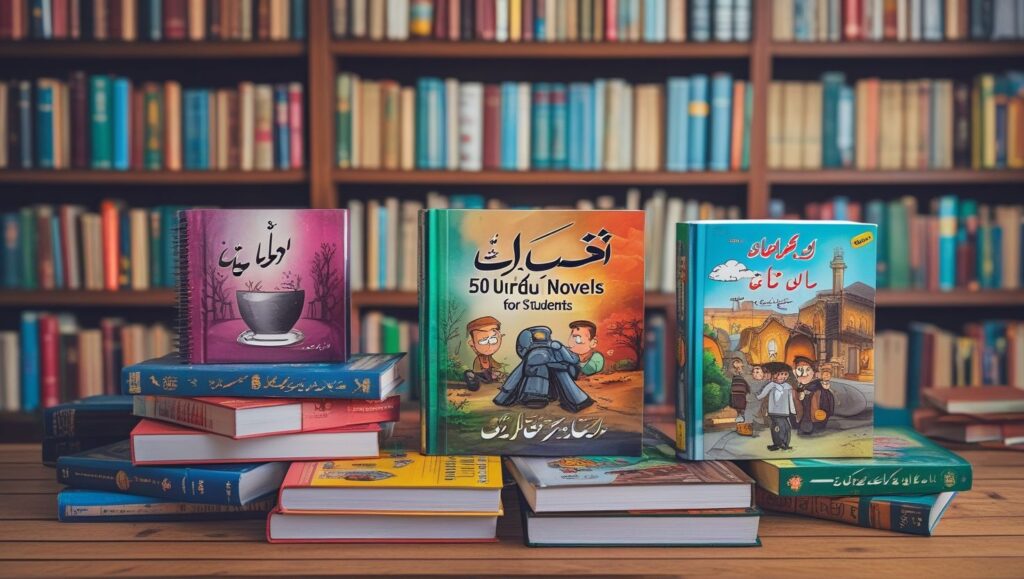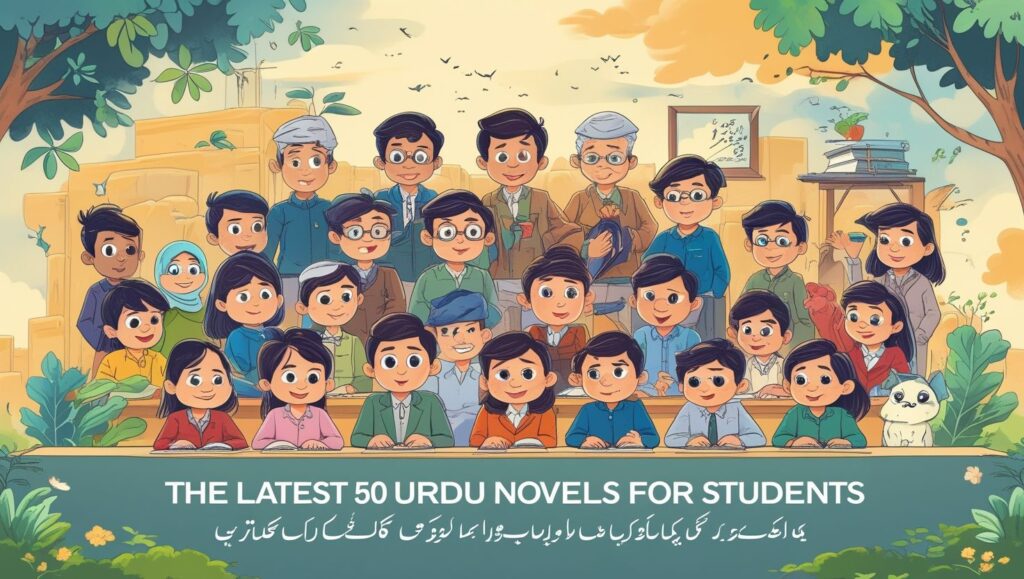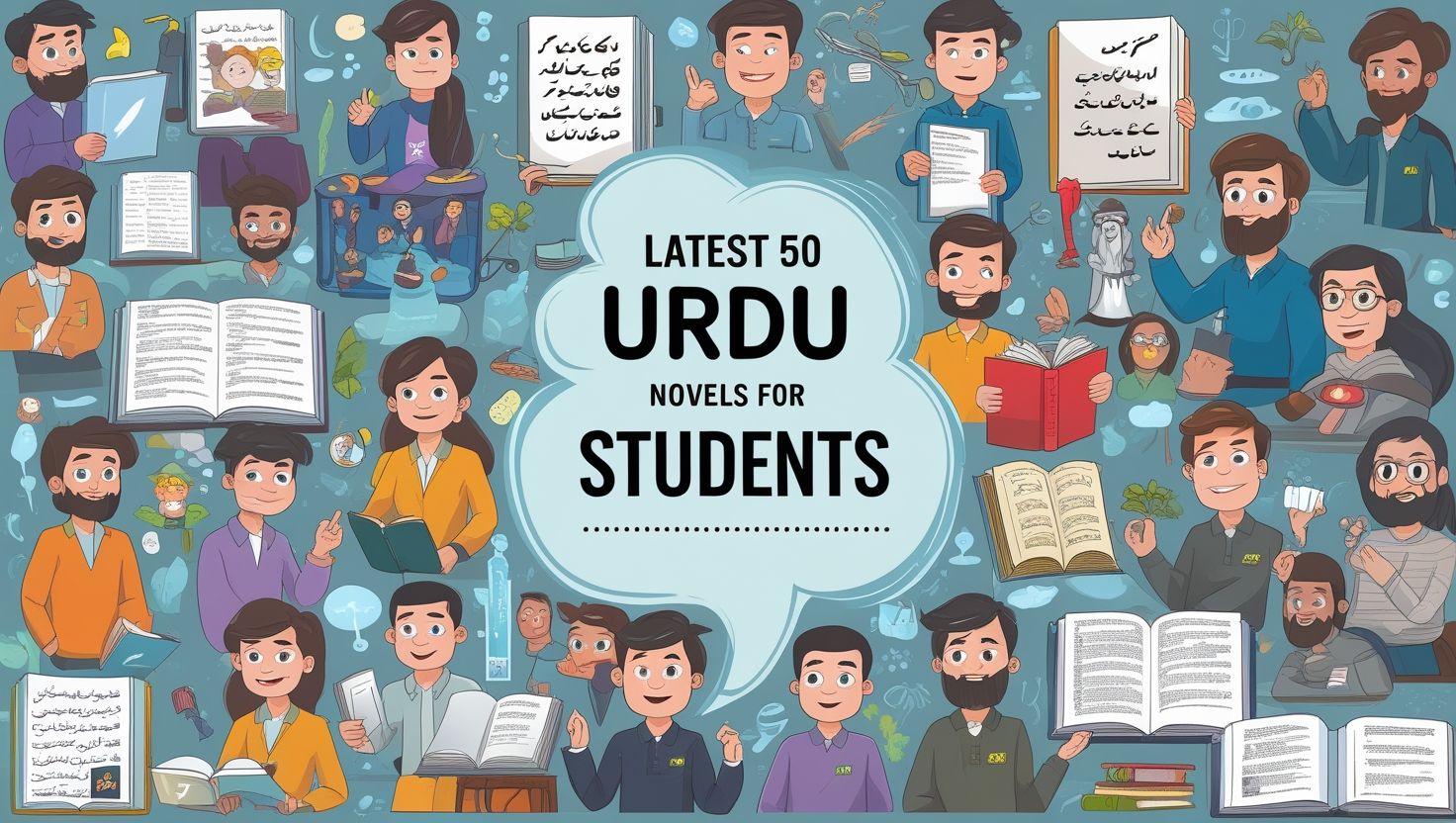Introduction
Latest 50 Urdu Novels for Students, Students need reading material that is engaging, accessible, and culturally rich. Therefore, this guide collects the latest 50 Urdu novels that students can read, study, and enjoy. Moreover, each section below gives a focused paragraph (about 140 words) so you can scan quickly. In addition, images of popular covers are included at the top to help visual learners recognize editions when searching libraries or shops.
Furthermore, the list mixes classics, modern hits, and digest/web novels so readers of all levels find something suitable. Consequently, teachers can use this as a semester roadmap while students can pick reading targets for improvement in vocabulary, comprehension, and critical thinking. For trusted bibliographies and curated collections, see Rekhta’s ebook listings and curated top-novel lists. Free download here
How the list was created
First, I prioritized readability for students. Next, I balanced literary significance and current popularity by checking community lists, e-libraries, and digest platforms. Also, I included works often recommended on KitabGhar and Goodreads to capture both traditional and web-serial readers. In addition, I aimed for genre balance: historical, social, romance, thriller, spiritual, YA, and children’s fiction. Further, novels were chosen for classroom discussion value: themes, character complexity, and cultural context. Finally, where possible, I preferred editions with notes or teacher resources to aid study. This method ensures that the list supports both pleasure reading and academic use.

Classics every student should try
Classics build the foundation of literary understanding. Start with Aag Ka Darya for panoramic history. Then read Umrao Jaan Ada to study character voice and cultural detail. Raja Gidh offers ethical and psychological depth, while Khuda Ki Basti tackles social realism and urban poverty. These novels provide diverse narrative techniques. Moreover, they are often referenced in exams and essays, so familiarity helps grades. Consequently, students learn to analyze symbolism, unreliable narration, and historical layering. In short, include at least one classic each term to deepen literary awareness and analytic skill.
Modern literary milestones to study
Modern milestones show how Urdu fiction evolved in the twentieth century. Udaas Naslein examines generational memory. Aangan offers partition-era family drama. Shahab Nama blends memoir with cultural critique. These works help students understand changing styles, from realist detail to introspective prose. Also, contemporary milestones are widely discussed in literary journals and newspapers, making them ideal for research projects. Therefore, reading these novels helps students connect literature to history and society. Consequently, teachers often pair them with primary historical sources for cross-disciplinary study.

Popular contemporary writers students love
Contemporary writers are readable and relevant. Umera Ahmed (e.g., Peer-e-Kamil, La-Hasil) and Nimra/Nemrah Ahmed (e.g., Mushaf, Jannat Ke Pattay) blend faith, suspense, and social themes. Farhat Ishtiaq and Hashim Nadeem produce works that adapt well to screen, which helps students compare text-to-TV adaptations. These writers use modern diction and fast-paced plots, so students build fluency quickly. Additionally, many modern novels tackle moral questions and youth dilemmas, making them excellent for classroom debates. In short, include one contemporary novel each month to practice modern registers and narrative economy.
Romance and youth-focused picks
Romance and coming-of-age novels appeal to younger readers and build empathy. Titles such as Humsafar, Pyar Ka Pehla Shehar, and Bachpan Ka December offer emotional arcs and social settings students recognize. Moreover, these novels often lead to adaptations, which aids media-literacy exercises. Because they use simpler language, they are great transitional reads before tackling denser classics. Therefore, teachers can assign romance novels for creative writing prompts and character studies. In addition, group discussions about relationship ethics and cultural norms sharpen critical thinking and public speaking skills.
Mystery, crime, and thrillers
Detective and thriller novels sharpen attention to plot and inference. Jasoosi Dunya (Ibne Safi) is a classic series for deductive reading. Modern suspense titles (digest hits and web-novels) teach foreshadowing and cliffhanger structure. These genres are excellent for reluctant readers because chapters are short and gripping. Furthermore, analyzing red herrings and clues builds logical reading skills that help in exams. Consequently, include at least one mystery novel per semester to practice identifying narrative strategy, authorial misdirection, and pacing.
Historical and partition narratives
History-focused novels help students form historical empathy. Works on partition and pre-/post-colonial life show how individual lives intersect with national events. Novels in this category often use multiple voices and unreliable narrators, challenging students to synthesize perspectives. Therefore, pair these novels with classroom timelines and primary sources to create interdisciplinary projects. In addition, many of these novels are used in civic education units because they discuss identity, displacement, and resilience—topics central to understanding the subcontinent’s twentieth-century history.
Digest-friendly and short-novel picks
Digest fiction and short novels are practical for busy students. They build momentum because chapters are episodic and easy to finish. KitabGhar and various online serial sites host many modern, digest-friendly titles that students read weekly. These novels are useful for vocabulary-building and for practicing summarization. Moreover, digest culture often produces serialized hits that encourage sustained reading habits. Thus, include digest picks in reading programs for consistent daily practice and for motivating hesitant readers.
Spiritual, moral, and reflective fiction
Spiritual novels—like several titles by Umera Ahmed and Nimra Ahmed—offer chances to discuss belief, ethics, and inner change. These works commonly present moral dilemmas and redemption arcs, making them suitable for classroom discussions on values and narrative framing. However, encourage students to read critically: examine how authors present faith and whether the narrative includes multiple viewpoints. As a result, spiritual novels become tools for both literary analysis and reflective writing assignments.

YA and children’s Urdu novels
Children’s and YA novels create the base for lifelong reading. Rekhta’s curated Top 10 Children’s Urdu Novels includes titles like Bilawal Ki Diary and Chand Ki Chori. These works use clear, age-appropriate language while teaching imagination and moral lessons. For schools, children’s novels are perfect for graded reading programs, oral reports, and vocabulary lists. Thus, younger students should start here before moving to denser novels. Also, these books often include illustrations that support comprehension, especially for visual learners.
Notable women writers and gender perspectives
Women writers—Qurratulain Hyder, Bano Qudsia, Khadija Mastoor, Farhat Ishtiaq—offer crucial perspectives on gender, family, and social roles. Their prose often emphasizes interiority and relationships, which makes them rich for character analysis. Moreover, gender-focused novels are ideal for essay prompts on social norms and for research on how literature shapes public discourse. Therefore, ensure your reading list includes multiple female voices to present balanced viewpoints and to broaden interpretive lenses.
Language practice and vocabulary builders
Use novels as a vocabulary lab. First, select a challenging paragraph. Next, underline unfamiliar words and create a vocabulary notebook. Also, use annotated editions and study guides to decode idioms. Pair a dense classic with a modern digest pick so students stay motivated while learning new terms. Furthermore, regular short sessions (20–30 minutes daily) are more effective than long, infrequent readings. Consequently, students will see steady improvement in fluency, idiom recognition, and expression.
Full catalog — the 50 recommended Urdu novels
Here is the complete, actionable 50-title catalog students can use. Pick by interest or level. 1. Aag Ka Darya — Qurratulain Hyder. 2. Umrao Jaan Ada — Mirza Hadi Ruswa. 3. Raja Gidh — Bano Qudsia. 4. Khuda Ki Basti — Shaukat Siddiqui. 5. Udaas Naslein — Abdullah Husain. 6. Aangan — Khadija Mastoor. 7. Shahab Nama — Qudratullah Shahab. 8. Peer-e-Kamil — Umera Ahmed. 9. La-Hasil — Umera Ahmed. 10. Hasil — Umera Ahmed. 11. Jannat Ke Pattay — Nemrah Ahmed. 12. Mushaf — Nimra Ahmed. 13. Humsafar — Farhat Ishtiaq. 14. Pyar Ka Pehla Shehar — Mustansar Hussain Tarar. 15. Bachpan Ka December — Hashim Nadeem. 16. Ghulam Bagh — Mirza Athar Baig.
17. Jasoosi Dunya (series) — Ibne Safi. 18. Aab-e-Hayat — Umera Ahmed. 19. Namal — Nimra Ahmed. 20. Haalim — Nemrah Ahmed. 21. Adhoora Pan — contemporary digest hit. 22. Shakh-e-Dil Zard Hai — newer romantic novel. 23. Diya Hai Hathon Par — digest favorite. 24. Mom Ki — popular digest fiction. 25. Main Anmol — student-friendly romantic. 26. Kinar Khawab Jo — contemporary short novel. 27. Ishq Nagar Ke Musafir — KitabGhar pick. 28. Mohabbat Gazeeda — modern fiction. 29. Namkeen Panio Ka Safar — modern collection. 30. Amarbel — contemporary hardcover. 31. Ali Pur Ka Aili — Mumtaz Mufti. 32. Bilawal Ki Diary — children’s novel. 33. Chand Ki Chori — children’s classic.
Full catalog — the 50 recommended Urdu novels
34. Ulta Darakht — children’s classic. 35. Sitaron Ke Qaidi — children’s adventure. 36. Black Monster — modern suspense. 37. Fasana-e-Zindagi — web serial favorite. 38. Teri Yaad Sath Hai — digest romance. 39. Pehli Mohabbat — teen love stories. 40. Yaaram — digest contemporary. 41. Selected study-edition classics — annotated. 42. Selected mystery novellas — short suspense pieces. 43. Morality & social critique novels — varied authors. 44. Travel/history novels by Tarar — nostalgic travelogues. 45. Modern feminist short novels — emerging writers. 46. Web-original bestsellers — serialized hits. 47. Contemporary anthology picks — mixed authors. 48. Selected KitabGhar long-serials — episodic reads. 49. Selected Rekhta-listed treasures — curated classics. 50. Recent digest chart-toppers — trending student picks. This catalog mixes canonical works and current digest/web favorites so students can choose by interest or reading level.

How to read these novels effectively (study plan)
First, plan a reading calendar—one novel every 3–6 weeks depending on difficulty. Next, keep a reading log with chapter summaries, vocab lists, and three discussion questions per chapter. Additionally, do close readings of one important passage per week. Pair novels with a short essay prompt and a 5-minute oral summary. Consequently, students improve writing concision and oral fluency. Also, compare a novel with its TV or film adaptation to analyze adaptation choices. Lastly, use available online resources and study editions to clarify historical or cultural references.
Practical tips for teachers and librarians
Create mixed-level reading groups. Assign one classic and one digest novel each term. Use quizzes on vocabulary and short-response tests for comprehension. Host book-talk sessions where students present a character study. Also, digitize chapter summaries to help absent students catch up. Importantly, encourage younger readers with illustrated editions first, then progress to unabridged texts. Finally, maintain a visible “student picks” shelf to promote peer recommendations and sustained reading culture.
Where to find these novels (libraries & online)
Look for annotated editions at university libraries. Use Rekhta’s ebook portal for classics and children’s titles. For contemporary and digest novels, KitabGhar and e-serial platforms often host episodes and downloadable chapters. Goodreads lists and community shelves help discover reader ratings and reviews. Also, local university bookstores and secondhand markets are great for hard-to-find editions. When buying, compare editions for helpful footnotes and glossaries to support student comprehension.
Conclusion — Read, reflect, and share
Reading Urdu novels enriches language, critical thinking, and cultural literacy. Therefore, use this Latest 50 Urdu Novels list as a flexible roadmap. Additionally, pair novels with short practice activities: vocabulary notebooks, oral summaries, and adaptation comparisons. Moreover, encourage students to swap books and write short reviews to build community. Finally, keep reading regular and varied; this is the most reliable way to move from reading for pleasure to reading for academic excellence.
References
- Rekhta — Urdu ebooks and curated novel collections. Rekhta
- KitabGhar — online serials, digest novels, and contemporary Urdu listings. kitaabghar.com
- Goodreads — community lists and reader-sourced “best Urdu novels” lists. Goodreads
- Dawn — literary roundups and historical lists of important Urdu books. Dawn
